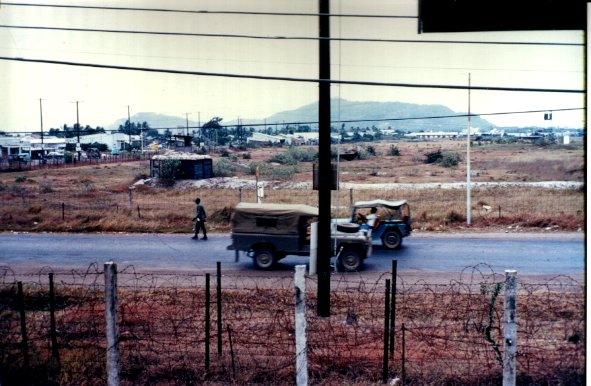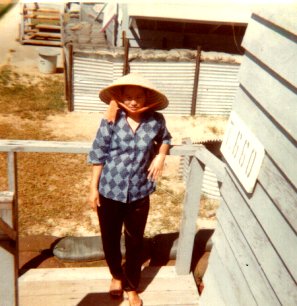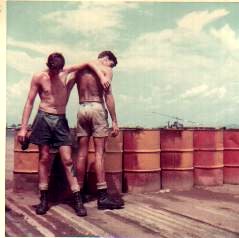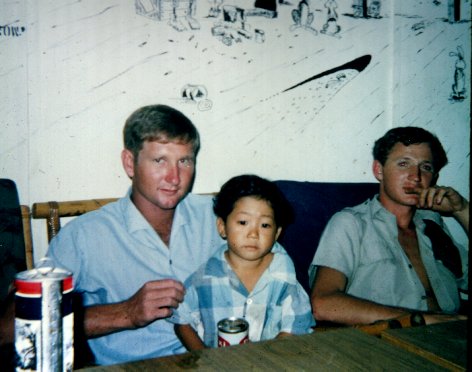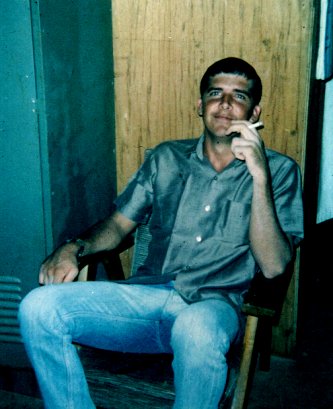|
|
||
|
|
Radschool Newsletter |
Vol 8 Page 7 |
|
|
||
|
Vietnam.
This issue we continue our memoires of the experiences enjoyed by RAAF blokes who were posted to Vung Tau in the mid to late 60’s, and as mentioned last issue, we’re only concerned with the lighter issues as there’s already been enough written about the terrible times.
Transport Flight Vietnam, later renamed 35 Sqn, was formed on the 21 July, 1964, and by the end of August, a total of 7 Caribou aircraft were deployed at Vung Tau. 9 Sqn, with their 8 x B model Iroquois had arrived a bit earlier—on the 6 June.
In its “heyday” Vung Tau had been a seaside resort town for wealthy French and Vietnamese families and was a bit like our Gold Coast.
9/35Sqn hanger and tarmac area at Vung Tau. Surface was nearly all PSP matting, which was hard on tyres. Hill in background was known as Radar Hill.
It had plenty of sun, beautiful beaches and some lovely old buildings. Originally, the RAAF were billeted in US Army tents set up on the airfield at Vung Tau, but conditions were not to their liking with noisy machinery operating 24 hours a day, and an open sewer at the back door, so they set up shop in town and bunked down in a hired villa, much to the annoyance of the US Army Base Commander. A lot of blokes who went through Vung Tau in the early days will have fond memories of Villa Anna.
RAAF compound, Vung Tau.
The old open ended hanger from which 9 and 35 Sqn’s operated was brought from an old WW2 airfield near Parkes, NSW and then re-assembled. In late 1966 suitable accommodation was completed, although it was built right on the wire, and the RAAF moved back to the air field.
The RAAF living quarters were some distance from the tarmac area, and the normal form of transport for airman to and from “work” was in the back of a diesel, 6 wheel drive, Studebaker truck (Old Smokie) on loan from the US Army.
This old bus, which like all other vehicles, apart from the odd Landy, was left hand drive, and this one had done about a million miles and was close to the end of its service life.
It would leave a large black cloud in its wake, and blokes with a heavy vehicle license would line up to drive it, rather than sit in the back.
View from the “front door” of one of the RAAF huts—showing the proximity to the “outside” . All that separated the blokes’ huts from outside was the 6ft tangled wire fence. Main gate to the base was just to the left.
A favourite form of amusement was to get the old Studey up to speed, then back off until passing a bunch of Yanks who were walking, then floor the accelerator. This pumped a heap of dieseline into the tired old engine, producing a huge black cloud from the exhaust which was strategically placed so it pointed directly towards the right hand side of the vehicle, straight at the pedestrians. This pungent black cloud would completely smother the yanks and send them spluttering and cursing “you bastard Australians”.
Despite being in the middle of a war zone, conditions at Vung Tau could only be described as “pretty good”. Food in the mess was excellent and plentiful and the RAAF even provided the blokes with a “wash girl” who’s job it was to wash all the bloke’s clothes, linen etc. (A lot felt this practice should have been continued “back home”). The Navy might think they’re the Senior Service, and the Army might think they’ve got The Edge, but of course we know better. After all, who every heard of a RAAF bloke wanting to eat in an Army mess…..
Accommodation consisted of a series of long wooden huts, with about 20 beds down each side. Each bloke was issued with a bed, a small bedside cabinet, a two door metal locker, an SLR rifle (but no bullets–you might shoot someone) and a “TV” chair. Normally lockers were placed side by side, in pairs, which divided the hut into small sections each containing 2 beds. Everyone was issued with a 100 day Figmo, (finally I get my orders) which was a drawing of a girl divided into 100 small pieces - like a jig-saw puzzle, and 100 days before being sent home you started to fill in the pieces with a pen. No prizes for guessing where section 100 was.
Unless there was an aircraft in the hanger for a “D”, which would give the blokes something to do, once all aircraft were pre-flighted and sent off for the day, there was not a lot to occupy the blokes until the aircraft came home again towards last light when they would have to be afterflighted, fixed, fuelled and oiled. During the day, in the late 60’s, the sumpies, ably led by Neil Harris, set to and built a beach buggy for use at back beach. They scrounged seats, wheels, dif, axles, brakes, engine, steering system etc from everywhere, and had it finished apart from the all important drive shaft which eluded them for some time, until Neil came up with the idea of swiping the front-shaft from the CO’s Jeep. This got the beach buggy going, but it left the CO without the use of the 4WD facility on his Jeep. We never heard whether or not he ever got stuck, or if he ever found out.
Radio blokes at 9 and 35Sqn were predominately black box changers as all U/S radio equipment was sent off to the Yanks and exchanged for serviceable items, though at one stage the RAAF had to send Allan George over to help the Yanks fix the Collins 618T HF sets. Over time, queer traders became very good at refuelling and oiling aircraft.
Overheard in a bar…… “I don’t think I’ll ever get married, any woman that would want to marry me would have to be bloody stupid, and I wouldn’t want to marry someone that stupid.
Entertainment on base was pretty good, and was designed to keep the blokes from seeking out horizontal dancing partners down the street. Airman had their Ettamoga Club, a Kingstrand hut transformed into a little bar with heaps of atmosphere. It was named after the cartoon that appeared in the magazine Australasian Post. Ken Maynard, the creator of the cartoon, visited Vung Tau and left a number of purposely created cartoons which decorated the walls. VB, Tooheys Flag and XXXX, as well as Yankee beers, sold in the Club for 12¢ a can as did goffers (soft drinks) - if you didn’t drink alcohol you were known as a “goffer scoffer”. That was the era when Bacardi-coke was “the drink”, and many a private party was built around it. New-comers to Vung Tau were always caught out by the old hands who would offer to buy the Bacardi, if “you grab the coke”. Trick was a 40oz (1,140ml) bottle of Bacardi cost about $1.35 while a slab of coke cost $2.88 (12¢ a can).
It was also the time when a lot of blokes were introduced to the stereo FM tuner/amp for the first time, as these were still very rare “back home”. They were sold at the Yankee PX, and most blokes bought one and awoke each morning to “Goooooooood Morning Vietnam” on AFVN radio (the power of music), just like in the movie. National had just released their excellent R100 shortwave receiver, which was also a favourite, and most blokes had one so they could listen to the footy or the cricket, or just to keep up with things at home, via Radio Australia.
L-R: Peter Thom (35Sqn framie) and Bob Meyer (35Sqn Inst) showing the results of a “time filling” paint fight.
Back in the late 60’s, an Aust dollar bought US$1.15, (things have changed) and all pays were first converted into Yankee dollars then made in MPC (Military Payment Certificate) which was a kind of Monopoly money used by the US armed forces as a means of keeping down black market activities. It didn’t, but that was its purpose. Most blokes quickly discovered that you could buy just about anything “down town” for a carton of Salem cigarettes (green gold), or a couple of cakes of Lux soap—you didn’t need money.
A bloke was on his deathbed. His wife was maintaining a vigil by his side, she held his fragile hand and tears ran down her face. He looked up at her and said: “My darling I have something I must tell you”. “Hush dear”, she said, “don’t talk”. “I must” he said, “there is something I must confess to you”. “There’s nothing to confess” she said, “everything’s OK, go to sleep”. “No, no, I must die in peace”, he said, “I slept with your sister, your best friend and with your mother”. “I know”, she said, “that’s why I poisoned you!”
Saturday night in the Ettamoga was known as pewter night as it was customery to present all blokes going back to Aust the following Wednesday (on the Freedom Bird) with their Selanga pewter mug. This strange ritual was usually carried out late in the night, after everyone had consumed buckets and buckets of booze, and involved all those getting mugs to assemble at the bar, and once their mugs had been filled with some form of alcoholic beverage, (usually a mixture of several different types – all potent) they raced to see who was the fastest at downing the mug and when empty, placing it up side down on their head.
This was immediately followed by all mug-getters dropping the duds, placing a sheet of rolled up newspaper between their legs, and racing from one end of the club to the other and then back again, with the paper on fire. Idea was to get there and back before the fire did some dreadful damage to one’s personal bits.
L-R: Dave Tottenham and Allan George (both 35Sqn radio) with “friend” in the Ettamoga, Dec, 1969. (Anyone know where Dave is these days??)
It was not unknown for some sadistic onlooker to soak some of the paper with Zippo lighter fluid—which usually had the effect of driving the racer onto greater efforts.
Next to the Club was an open air theatre that showed movies via a Bell and Howell 16mm projector, and at times would be the forum for Australian entertainers who put on very well attended live shows for the blokes.
Supplies for the Australians in Vietnam were either transported by Herc or sent via sea in the Navy supply ship “The Jeparit”. In the late 60’s the protest movement was at it’s height in Australia, and at one stage the wharfies refused to load the ship for some weeks, with the result Australians ran out of Australian goods. The cry went up in Vung Tau - "Wallop a wharfie".
No-one actually ran out of anything as shortfalls were made up from Yankee stores, but having to use Yankee soaps, tooth pastes, smokes, beers etc just because some blasted wharfie refused to load the ship left a nasty taste in everyone’s mouth.
When the Jeparit did return to Vung Tau, chock full of Aussie stuff, a bunch of lucky blokes were invited on board for a celebratory “long since seen” stubby. (Most drinks were delivered to Vung Tau in cans—a stubby was a luxury). The Navy crew wisely provided two large tubs of fresh water to wash the salt off the stubby prior to drinking the contents. One tub was labelled Melbourne water, the other Sydney water. That little gesture went down well.
"Jack" Gleeson, 35 Sqn Loady, "Taking it easy".
Next issue:- Life down town...
|
||
|
If you’re into ancestry stuff, and want to know who else in the world has your name, try logging onto http://www2.egosurf.com/ (yep—the www2 bit is correct)
You can type in your name and it will search the net for similar names. Try it!! |
||
|
|
||
|
Scope Iron.
Our competition question last issue re the use of the scope iron was very topical and bought in heaps of answers, some of which were fabulous - seems the old scope was a much loved piece of equipment. Most blokes reckoned the answer was “E - All of the above” and Rick Toholka even quoted the “RASCAL Exam Flight” gospel according to Allan George to back up his answer. Some of the replies are definitely worth repeating here….
John Dixon wrote:- I used to own a scope iron, and believe me you could brand cattle with it and you could drill/burn holes in almost anything, but sadly and I hate to admit it and if it gets out I'll deny everything, I have melted a few IC's. so, answer B. At first I threw out the 3.3 volt transformer and used it as a portable iron by attaching it to a car battery. I then had the mother of all scopes, and could vapourise several IC's at once and even start fires. Sadly I had the throw it away as the insides seized up.
Geoff Mayhew wrote:- I’ve used a scope iron for:- Burning a message into that piece of leather that used to come above the hip pocket of blue jeans. Using the transformer to supply the right amount of juice to heat up a piece of wire to cut the necks off stubbies. As an immersion heater to heat a cup of milk on those cold nights on a maintenance shift. Burning holes into masonite to make a peg board. Using the transformer to hold down a chassis whilst using a nibbling tool, and finally the nearest thing that I can think of to its actual designed use: To desolder the top cap of a large output valve before breaking off the tit, filling the valve with water, turning the power back on to the circuit and having your very own Gurgletron!
John Butler wrote:- Given the diversity of tasks to which the good old Scope iron was subjected, it wouldn't surprise me one bit if it had been used to brand cattle. It has certainly branded a few Radtechs over the years - and they have the scars (or is that "brands") to prove it. Bloody marvelous what the Scope iron would do when you had the tip actually glowing red hot. Now I speak from bitter personal experience here, when I admit to frying a few IC's or transistors with the old Scope iron. Very hard to get good temperature control, as I recall. I suppose that we should not mention that the "Good Old Scope" was the chief cause of de-lamination of those vveeerrrryyyy expensive circuit boards, not to mention holes burnt in bench tops, clothing and Radtechs.
I have no personal experience in ironing shirts with the Scope, but I am sure that there are those that can tell a tale or two. Couldn't be any harder than ironing 'em with an iron, though, could it? I recall that the Scope iron reacted poorly to being used as a lever - used to crack the handles something fierce and they never seemed to work as well after that. But, anything's possible, I suppose.
|
||
|
Counter Since March 2017 |
||
|
|
||
|
|
||
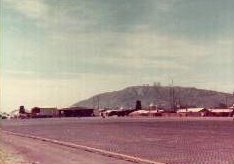
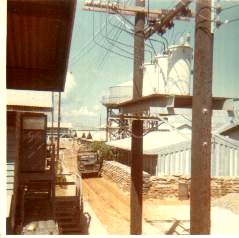 5
ACS arrived at Vung Tau in May 1966 and commenced erecting a
maintenance hanger, 4 Kingstrand huts, 3 admin buildings, chopper
landing pads and tarmac areas.
5
ACS arrived at Vung Tau in May 1966 and commenced erecting a
maintenance hanger, 4 Kingstrand huts, 3 admin buildings, chopper
landing pads and tarmac areas. 